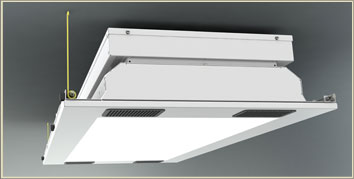Designed specifically for hospitals, nursing homes, child care centers, and other healthcare facilities where infection control is a concern, the Arcalux Health Risk Management System (HRMS) is an energy-efficient lighting fixture that doubles as a germ-killing machine.
The fixture incorporates air circulation modules, a filter, and an ultraviolet germicidal irradiation module that together pull in surrounding indoor air and eliminate up to 99% of pathogens in a single pass. The system uses differential pressure and directional airflow to isolate and kill contaminants in the fixture. It's installed in the existing electrical infrastructure with no structural, HVAC, or duct modifications.
The patented device could save lives and healthcare institutions dollars by destroying disease-causing pathogens from air and reducing hospital-acquired infections (HAI). The Centers for Disease Control estimates that $45 billion is added to the annual healthcare costs to treat HAIs. They are the fourth major cause of death with an estimated 1.7 million patients contracting an HAI, resulting in 99,000 deaths each year.
American Green Technology, Inc. (AGT) announced at Lightfair last week that it has signed a licensing agreement with Arcalux Corporation to manufacture, market, and sell Arcalux HRMS and other products from the company, through AGT's agents.
"We're excited about introducing this new product," said Danny Bogar, chief executive office of AGT. "Virtually every day you read a story about how people are dying from airborne pathogens in hospitals - a place where you normally go to regain good health. The Arcalux product addresses these health concerns."
Related Stories
K-12 Schools | Mar 1, 2015
Are energy management systems too complex for school facility staffs?
When school districts demand the latest and greatest, they need to think about how those choices will impact the district’s facilities employees.
Office Buildings | Mar 1, 2015
Google unveils dramatic tent-like, modular-focused plan for corporate HQ
The master plan by Bjarke Ingels and Thomas Heatherwick will wrap highly flexible office blocks in soaring translucent canopies.
Industrial Facilities | Feb 27, 2015
Massive windmill will double as mixed-use entertainment tower in Rotterdam
The 571-foot structure will house apartments, a hotel, restaurants, even a roller coaster.
Architects | Feb 27, 2015
5 finalists announced for 2015 Mies van der Rohe Award
Bjarke Ingels' Danish Maritime Museum and the Ravensburg Art Museum by Lederer Ragnarsdóttir Oei are among the five projects vying for the award.
Office Buildings | Feb 26, 2015
Using active design techniques to strengthen the corporate workplace and enhance employee wellness
The new Lentz Public Health Center in Nashville, Tenn., serves as a model of how those progressive and healthy changes can be made.
K-12 Schools | Feb 26, 2015
Should your next school project include a safe room?
Many school districts continue to resist mandating the inclusion of safe rooms or storm shelters in new and existing buildings. But that may be changing.
K-12 Schools | Feb 26, 2015
Construction funding still scarce for many school districts
Many districts are struggling to have new construction and renovation keep pace with student population growth.
K-12 Schools | Feb 26, 2015
D.C.'s Dunbar High School is world's highest-scoring LEED school, earns 91% of base credits
The 280,000-sf school achieved 91 points, out of 100 base points possible for LEED, making it the highest-scoring school in the world certified under USGBC’s LEED for Schools-New Construction system.
K-12 Schools | Feb 25, 2015
Polish architect designs modular ‘kids city’ kindergarten using shipping container frames
Forget the retrofit of a shipping container into a building for one moment. Designboom showcases the plans of Polish architect Adam Wiercinski to use just the recycled frames of containers to construct a “kids city.”
Cultural Facilities | Feb 25, 2015
Bjarke Ingels designs geodesic dome for energy production, community use
A new building in Uppsala, Sweden, will serve as a power plant during the winter and a venue for shows, festivals, and music events during the warm months.

















